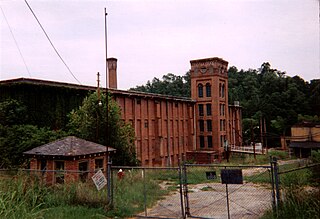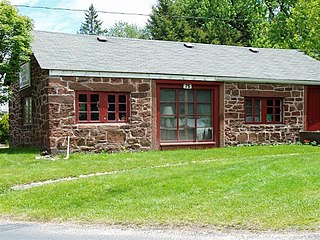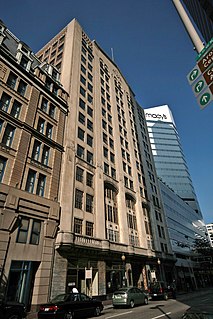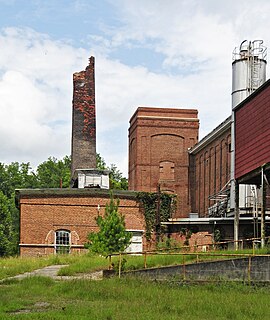
The Mechanic Street Historic District encompasses a historic 19th-century mill and mill village in a 14-block area of the Pawcatuck section of Stonington, Connecticut. Extending along the Pawcatuck River and south of West Broad Street, the area includes a large brick mill complex on the banks of the river, and a neighborhood of well-preserved worker housing on the road grid to its west. The district was listed on the National Register of Historic Places in 1988.

Newry is a census-designated place in Oconee County, South Carolina, United States. According to the 2010 United States Census, the population of the CDP was 172.

Carolina is a village that straddles the border of the towns of Charlestown and Richmond on the Pawcatuck River in Washington County, Rhode Island. Rhode Island Route 112 passes through the village. Carolina is identified as a census-designated place for reporting of data from the 2010 census.

The Blackstone Manufacturing Company Historic District encompasses the "New City" or "High Rocks" area of Blackstone, Massachusetts, an industrial village associated with the Blackstone Manufacturing Company, which began operations in 1809. It includes an area roughly surrounding Butler, Canal, Church, County, Ives, Main, Mendon, Old Mendon, and School Streets. The district includes a wide variety of worker housing, as well as a granite storehouse, the only surviving company structure. The district was added to the National Register of Historic Places in 1995.

The Somersville Historic District encompasses the historic components of the mill village of Somersville in western Somers, Connecticut, United States. The district is centered on a mill complex on the Scantic River, which divides the district. The most significant years of development were between about 1835 and 1935, although the area has a history dating to the 1760s. The district was listed on the National Register of Historic Places in 1995. The Mill itself has since burned down and as of October 2018 is currently open field, although the canal structure remains in place.

The Central Village Historic District is a historic district in the Central Village area of Plainfield, Connecticut that was listed on the National Register of Historic Places (NRHP) in 1991. It encompasses a late 19th-century historic mill village, including a small commercial center where Connecticut Route 12 and 14 meet, a cluster of architecturally distinguished buildings built by mill owners and managers, and a collection of mill worker housing units. It includes the Plainfield Woolen Company Mill, which is separately listed, as well as archaeological remnants of other mill infrastructure. It also includes Plainfield's old town hall and high school. Other architecturally prominent buildings include the c. 1855 Italianate mansion of mill owner Arthur Fenner, and the 1845 Greek Revival Congregational Church.

The Mill Village Historic District is a historic district encompassing a well-preserved 19th century mill village in Williamstown, Massachusetts. It is located on Cole Avenue and other streets east of Cole and south of the Hoosac River, which provided the mill's power. The complex dates to the mid-19th century, and includes tenement houses, housing for supervisors and specialty personnel, as well as a surviving mill building. The village district was listed on the National Register of Historic Places in 1983.

The Ware Millyard Historic District encompasses a 19th-century mill complex and industrial mill village in the town of Ware, Massachusetts. It is roughly bounded by South Street, the Ware River, Upper Dam Complex, Park Street, Otis Avenue and Church Street. The area includes surviving mill buildings, the oldest of which date to the 1840s, and a collection of tenement-style housing built for the millworkers, built between 1845 and the 1880s. The district was listed on the National Register of Historic Places in 1986.

District B is a historic worker housing district located in Manchester, New Hampshire, near the former Amoskeag Manufacturing Company millyard. It is roughly bounded by Canal, Mechanic, Franklin, and Pleasant Streets, and was added to the National Register of Historic Places on November 12, 1982. It contains 32 contributing properties, including seventeen rowhouse tenement blocks built mainly between 1838 and 1850, in an area of approximately 170 acres (69 ha).

Hallville Mill Historic District is a historic district in the town of Preston, Connecticut, that was listed on the National Register of Historic Places in 1996. Contributing properties in the district are 23 buildings, two other contributing structures, and one other contributing site over a 50-acre (20 ha) area. The district includes the dam that forms Hallville Pond, historic manufacturing buildings and worker housing, and the Hallville Mill Bridge, a lenticular pony truss bridge built circa 1890 by the Berlin Iron Bridge Company.

Lockwood, Greene & Co. was an American architectural firm.

The Vaucluse Historic District, located in Vaucluse, South Carolina in Aiken County. The district includes the mill, number of accompanying buildings, and over eighty mill village homes. The district is noteworthy in that it is considered to be oldest mill village in the state. No less significant, the mill building, completed in 1877, was based on the plans of architect Amos D. Lockwood. Lockwood's successor firm, Lockwood, Greene & Company, would later design around fifty of South Carolina's textile manufacturing facilities. The Vancluse Historic District was listed in the National Register of Historic Places on May 7, 1996.

The North Charlotte Historic District is a 155.5-acre (62.9 ha) national historic district located in Charlotte, Mecklenburg County, North Carolina. The listing included 282 contributing buildings and four contributing structures. It includes work designed by architect Stuart Warren Cramer; it includes Bungalow/craftsman, Late Victorian, vernacular Victorian, reflecting turn-of-the-century mill-village architecture. Located in the district is the separately listed Highland Park Mill No. 3. Other notable buildings include the Mecklenburg Mill, Johnston Mill (1913), Grinnell Manufacturing Company, Hand Pharmacy Building (1904), Lowder Building (1927), the former Highland Inn, Charlotte Fire Department Engine Company No. 9 (1937), and North Charlotte Primary School.

Woodside Cotton Mill Village Historic District is a national historic district located in Greenville County, South Carolina. The district encompasses 278 contributing buildings and 2 contributing sites in an early 20th century urban South Carolina textile mill village. Centered on a mill founded by John T. Woodside in 1902, the district is located just west of the city limits of Greenville and is largely intact despite modernizations made by a succession of mill and home owners. The mill itself is a rectangular, brick, four-story building designed by J.E. Sirrine and built between 1902 and 1912. Eventually the mill became the largest cotton mill under one roof in the United States and one of the largest in the world.

Erlanger Mill Village Historic District is a national historic district located at Lexington, Davidson County, North Carolina, USA. The district encompasses 282 contributing buildings and 7 contributing structures in a predominantly residential section of Lexington. The mill village dwellings were built between about 1916 and 1929 and include notable examples of Bungalow / American Craftsman style architecture. The dwellings were constructed by the Erlanger Mill Company as worker's housing and in a subdivision designed by noted landscape architect Earle Sumner Draper (1893–1994). The mill itself is a complex of one- and two-story mill buildings constructed from 1913 through the 1960s. Also located in the district are the Erlanger Baptist Church (1936) and Erlanger Graded School.

Thomas F. Lloyd Historic District is a national historic district located at Carrboro, Orange County, North Carolina. The district encompasses 25 contributing buildings developed as housing for textile mill workers associated with the 1910 Thomas F. Lloyd Manufacturing Company. The district's buildings date between 1910 and 1915 and are primarily one- and two-story frame mill worker dwellings. A notable dwelling is located at 214 Maple Avenue, which was reportedly built by Thomas Lloyd as a "guest house" for the mill.

Alexander Manufacturing Company Mill Village Historic District is a national historic district located at Forest City, Rutherford County, North Carolina. It encompasses 87 contributing buildings in a predominantly residential section of Forest City developed by the Alexander Manufacturing Company. The mill village developed after 1918, and includes notable examples of Colonial Revival and Bungalow / American Craftsman style architecture. Landscape architect Earle Sumner Draper’s planned the curvilinear village plan. Notable buildings include the Alexander Manufacturing Company mill complex, former Alexander School, and Alexander Baptist Church.

The Warren Mill is a historic textile mill complex at South Carolina Highway 421 and Trestle Pass in Warrenville, South Carolina. It consists of a main four-story brick building, to which a number of one and two-story additions have been made. It was built in 1896-98 to a design by William B. Smith Whaley, a regionally prominent architect of industrial properties. The Warren Manufacturing Company was incorporated in 1896, and operated on the premises until 1919, when it was acquired by the Graniteville Mill Company. It operated the plant until its closure in 1982.

The Union Village Historic District encompasses the core of a historic 19th-century residential mill village in Manchester, Connecticut. Radiating north and west from the junction of Union Street and North Main Street, the area was developed in the first half of the 19th century has a company town, but evolved into a mixed working-class community in the 20th century. It was listed on the National Register of Historic Places in 2002.


























